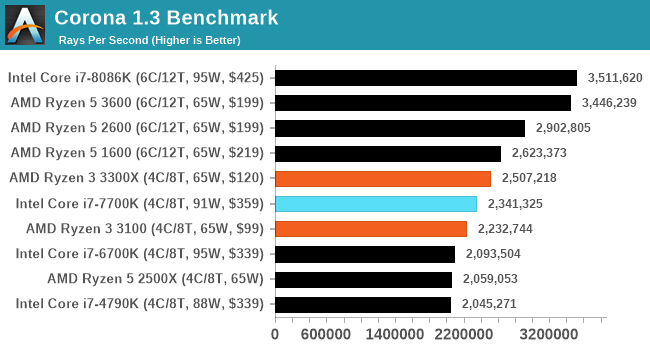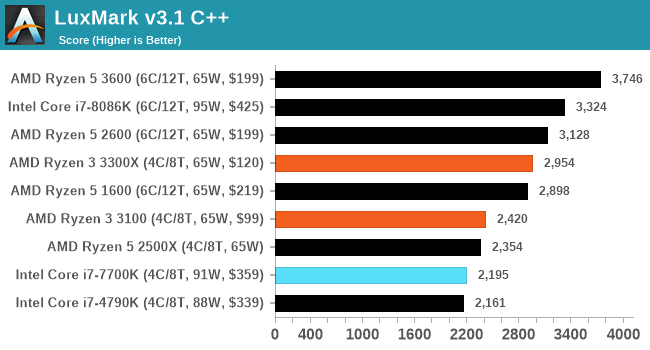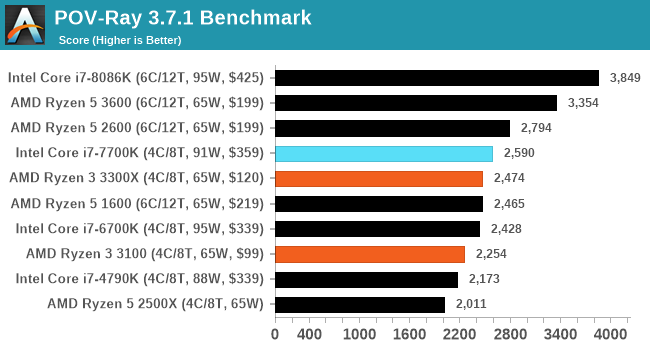The AMD Ryzen 3 3300X and 3100 CPU Review: A Budget Gaming Bonanza
by Dr. Ian Cutress on May 7, 2020 9:00 AM ESTCPU Performance: Rendering Tests
Rendering is often a key target for processor workloads, lending itself to a professional environment. It comes in different formats as well, from 3D rendering through rasterization, such as games, or by ray tracing, and invokes the ability of the software to manage meshes, textures, collisions, aliasing, physics (in animations), and discarding unnecessary work. Most renderers offer CPU code paths, while a few use GPUs and select environments use FPGAs or dedicated ASICs. For big studios however, CPUs are still the hardware of choice.
All of our benchmark results can also be found in our benchmark engine, Bench.
Corona 1.3: Performance Render
An advanced performance based renderer for software such as 3ds Max and Cinema 4D, the Corona benchmark renders a generated scene as a standard under its 1.3 software version. Normally the GUI implementation of the benchmark shows the scene being built, and allows the user to upload the result as a ‘time to complete’.
We got in contact with the developer who gave us a command line version of the benchmark that does a direct output of results. Rather than reporting time, we report the average number of rays per second across six runs, as the performance scaling of a result per unit time is typically visually easier to understand.
The Corona benchmark website can be found at https://corona-renderer.com/benchmark

LuxMark v3.1: LuxRender via Different Code Paths
As stated at the top, there are many different ways to process rendering data: CPU, GPU, Accelerator, and others. On top of that, there are many frameworks and APIs in which to program, depending on how the software will be used. LuxMark, a benchmark developed using the LuxRender engine, offers several different scenes and APIs.
In our test, we run the simple ‘Ball’ scene on both the C++ and OpenCL code paths, but in CPU mode. This scene starts with a rough render and slowly improves the quality over two minutes, giving a final result in what is essentially an average ‘kilorays per second’.

POV-Ray 3.7.1: Ray Tracing
The Persistence of Vision ray tracing engine is another well-known benchmarking tool, which was in a state of relative hibernation until AMD released its Zen processors, to which suddenly both Intel and AMD were submitting code to the main branch of the open source project. For our test, we use the built-in benchmark for all-cores, called from the command line.
POV-Ray can be downloaded from http://www.povray.org/












249 Comments
View All Comments
alufan - Friday, May 8, 2020 - link
just curious if I follow the "bench" link it shows Intel at the top of the stack in the opening page, yet when I choose to look at the actual results with the drop down then the results change, yet the opening page is from a benchmark in which the Thread ripper has not even been tested on, the whole industry recognises that its probably the single fastest chip out there for the HEDT platform yet your opening page shows Intel at the top and no 2020 results, once again this looks like careful manipulation of the results and the casual viewer dropping on the page just sees the top 4 out of 6 positions taken by Intel with TR2 mixed in and no mention of TR3 not a very fair page and it gives a poor impression and a possibly misleading impression to folks who know no better and instantly get the impression Intel sells the highest performing CPUs which we know is not the case anymoreqwertymac93 - Friday, May 8, 2020 - link
There are two versions of "bench" for CPUs. "CPU" & "CPU 2019". You need the 2019 one to see the more recent results.alufan - Saturday, May 9, 2020 - link
and thats what I did clicked the link in the article and ended up with a page showing intel as having all the top spots which we all know is no longer the case...that was my point the opening summary page should reflect the results not the results of 2 years ago, and its now month5 of 2020 not 2019 "latest" results should be 2020zodiacfml - Friday, May 8, 2020 - link
This 3300x is something beats the six core 2600. In some reviews, it is equal to 3600 in games while a slightly behind in rendering tasks. I have already decided that a six-core is minimum for me since the 1600 but this...andrewaggb - Friday, May 8, 2020 - link
It's pretty good for what it is but for a cheap PC, intel has graphics. For a cheap gaming PC it's a bargain now but probably won't age well with 8 core consoles coming out this year. If you can afford the 3700x (or better), that should last 8+ years for gaming.Tchamber - Friday, May 8, 2020 - link
The Ryzen 3 3200G had preside graphics, too.ahenriquedsj - Saturday, May 9, 2020 - link
Good job.Mugur - Saturday, May 9, 2020 - link
Ian, sorry to say this, but you must find another organisation for you. Anandtech is just the ghost of what it was. You need at least what every youtuber has to conduct a decent set of benchmarks. You need to buy cpus, videocards, etc. for decent testbeds when they not sampled to you. I'm sick of seeing obscure outfits with every cpu and gpu possible, while a real expert is using a 1080 etc.Rudde - Saturday, May 9, 2020 - link
Will you update the conclusion to include 3100?lmcd - Saturday, May 9, 2020 - link
That board compatibility diagram must be flawed because my B350 board from ASRock has validated support for everything in the 3XXX series.